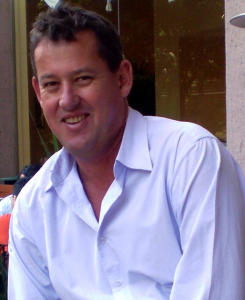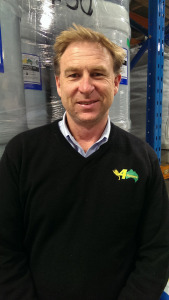Rethinking Australia

Accensi entered the agchem market two years after the patent on glyphosate expired and more were set to lapse. “By 2003 we had facilities on both sides of the country and therefore were able to offer a service no other formulator could match.” –Dean Corbett, Accensi CEO
In Australia, the big influence is – and always will be – the weather. Drought is a fixture. Dean Corbett, CEO of Queensland-based manufacturer Accensi, says that in his 24 years in the crop protection business, he has seen far more dry years than good. “The market is crowded because people only see the good seasons; each year there are more and more registrations of the same products, yet the market on year in, year out averages grows at under 5%.” He has seen many companies “badly burned” because they don’t have access to market or a strong position in manufacturing.
“The last few years have seen a lot of small players drop out of the market and a deconsolidation of many multinational trading arrangements. It’s almost like the rise and fall of the tides, but in each ebb and flow the overall industry margins are eroded even further.”
The Australian crop protection sector produced almost $2.5 billion in output in 2011-12, as measured at the factory gate, according to CropLife Australia. It is estimated that up to $17.6 billion of Australian agricultural output is attributable to the use of crop protection products, or up to 68% of the total value of crop production. Over half of this contribution is from fungicides, reflecting their significant contribution to the value of production of vegetables, fruits and nuts.
The country’s crop protection market has notoriously low barriers to entry. Registration for copies is cheap and quick. Overseas companies, particularly the Chinese, see it as an easy entry with fully formulated products. Most fail.
It all sounds ominous, but, likewise, there is no shortage of success stories. First, the former.

“The market has become more discerning among generics rather than being purely driven by price. Suspicion of quality is another reason a new brand could find it tough.” –Neil Mortimore, general manager of 4Farmers, an importer based in Perth
Neil Mortimore, general manager of 4Farmers, an importer based in Perth, told Farm Chemicals International that foreign suppliers gaining more direct access and bypassing existing local companies have been perceived as a potential threat. Building up a registration portfolio is one thing, but successfully marketing the products at either wholesale or retail level is another. “The market has become more discerning among generics rather than being purely driven by price. Suspicion of quality is another reason a new brand could find it tough,” he said.
Eye Out for Illegal Imports
A common concern in the country, echoed by several of those interviewed, is that imports too frequently come from somewhere other than the registered source. An overseas registered factory might be out of stock of a certain product, so it calls its opposition and simply buys it from them. The regulator, Australian Pesticides and Veterinary Medicines Authority (APVMA), will audit the local formulators but do not audit the foreign suppliers, according to Corbett. He warned, “Recently we had a container of AI arrive that was not even the product ordered; it was totally different. It was lucky that it was an AI and not a finished product destined to be sprayed on food. The priorities of the APVMA need to change before a catastrophe occurs.”
Matthew Cossey, chief executive of CropLife Australia, acknowledged the growing problem. “There is mounting evidence that Australia is the target of considerable illegal imports of unregistered crop protection products. A strong Australian dollar, growing illegal production in Asia, established transport links and a strong market for cheap agchem products in Australia has created the perfect environment for organized criminal operators to profit from selling illegal product to Australian farmers.”
As of July 1, 2014, APVMA has undertaken a new spectrum of compliance and enforcement powers. The Agvet legislation gives the APVMA a specific range of compliance and enforcement powers for the purposes of monitoring and assessing compliance, managing risk, gathering information, and investigating and responding to noncompliance.
“It is essential that the relevant government agencies ensure that illegal products are stopped before making it onto the market and to ensure that all agricultural chemicals sold in Australia are legitimate and registered and can be used safely, for the sake of farmers, consumers, the environment and Australian agriculture,” Cossey said.
Promising New Venture
Although barriers to entry are low, Australia’s rigorous manufacturing regulations in combination with its low-margin market make simply surviving difficult. “Companies that don’t have the critical mass or market a single brand find it extremely hard to compete,” Corbett argued.
Nor are the industry giants invincible. Earlier this year, a major player, Nufarm Limited, was forced to close two manufacturing facilities and six regional service centers in Australia and cut jobs to save the struggling company $13 million a year. A month later it shuttered its Auckland, New Zealand plant and laid off 59 workers. BASF also ended its distribution deal with Nufarm and announced it would begin direct distribution in Australia as of March 2014.
![Tony Moskal, BASF head of agriculture for Australia and New Zealand, said growers in Australia have reacted “very positively to Sharpen [BASF branded herbicide,] as it doesn’t require glyphosate, with known resistance to control weeds, compared to other options in the market.” The product has been in the country for the past two years with a relatively low profile, but demand is increasing as issues with weed resistance management intensify.](https://www.farmchemicalsinternational.com/wp-content/uploads/2014/09/photo25-300x200.jpg)
Tony Moskal, BASF head of agriculture for Australia and New Zealand, said growers in Australia have reacted “very positively to Sharpen [BASF branded herbicide,] as it doesn’t require glyphosate, with known resistance to control weeds, compared to other options in the market.” The product has been in the country for the past two years with a relatively low profile, but demand is increasing as issues with weed resistance management intensify.
BASF’s products are now available in 650 stores throughout Australia with Landmark, Elders, AgLink, CRT, NRI and a number of independents as its key distribution partners. Its sales and technical team is in place, traveling extensively around the country to familiarize growers and distributors with its products. “One of the exciting results of being back in the Australian agriculture market is that we can confidently invest in and roll out a range of new products in the years to come,” he said.
According to Moskal, Western Australia has had a strong start to the season with reasonable rainfalls, which has translated into optimism in the broadacre cereal markets. South Australia and Victoria also continue to receive the benefits of early rain in the growing season, so growers are using herbicides and fungicides to maximize yields and optimize access to soil moisture. New South Wales has been hardest hit by drought.
While weed, disease and insect pressures persist, there is also a market for high-performing products, Moskal said. Growers, he added, have reacted “very positively to Sharpen [BASF branded herbicide,] as it doesn’t require glyphosate, with known resistance to control weeds, compared to other options in the market.” The product has been in the country for the past two years with a relatively low profile, but demand is increasing as issues with weed resistance management intensify.
Herbicide-resistant weed populations are now found throughout all cropping areas of Australia from Western Australia to central Queensland. Twenty-five weed species have been identified as being resistant to one or more herbicide mode-of-action groups, according to the Grains Research & Development Corporation.
New chemistries from multinationals like pyroxasulfone (Bayer CropScience’s Sakura) for ryegrass control, or pyrasulfotole (Velocity, also from Bayer) for another major weed, wild radish (Raphanus raphanistrum), have generated interest in spite of high costs, Mortimore said.
Like the United States, legacy generic chemistries have made a comeback in Australia. Trifluralin, after peaking, then virtually dying in the ’80s, had a renaissance in the ’90s that corresponded to the rise of ryegrass resistance. Still today it is one of the biggest chemicals after glyphosate with domestic consumption estimated at 12 million to 15 million liters, according to Mortimore. Triallate for grass control has increased, and bromoxynil has also seen strong resurgence to control broadleaf weeds and rotate away from more vulnerable herbicides.
Logistics is another issue that keeps the crop protection industry on guard, given the extent of existing pressures. Corbett explained, “We are seeing a need to produce in Queensland, Western Australia and Victoria in order to offer our clients the best value position. By using a local manufacturer, clients can decide at the last minute what formulation strength they want and what pack size to put it in.” As Accensi is now close to all three Australian markets with facilities in each, it is equipped to give clients “the best value proposition in terms of JIT [just-in-time inventory strategy] and market demands.”

Matthew Cossey, chief executive of CropLife Australia, explained that modernized regulation is now in place with the passage of a bill that removes unnecessary re-registration and re-approval of agricultural chemicals.
Step in the Right Direction
Still more opportunities are opening up on the continent. CropLife’s Cossey praised the recent positive strides made by the Australian government. In May, the government decided to fund a minor use and specialty crops program, despite significant pressure on the federal budget. “The government’s initial $8 million commitment [out of a $45-million fully funded program,] if utilized properly, will be a profitable investment in Australia’s agricultural sector. Economic analysis of the United States’ minor use program has estimated that for every dollar invested by the U.S. government in a similar initiative, the program facilitates a return to the U.S. economy of $550,” Cossey said.
Not only will a minor use program increase the productivity of Australian agriculture, he added, it stands to enable more environmentally friendly pest management practices. Accessibility to modern, target-specific chemicals can reduce the excessive use of older, broader-spectrum chemicals. A minor use program also encourages more investment in developing these products.
In another step in the right direction, a bill was passed in July that removes unnecessary re-registration and re-approval of agricultural chemicals.
“The passing of the Agricultural and Veterinary Chemicals Legislation Amendment (Removing Re-approval and Re-registration) Bill 2014 means that the primacy of protecting human health and the environment is maintained, and arbitrary time-based reviews will not undermine Australia achieving an efficient and effective regulator,” Cossey said.
Steady Demand
Although current seasonal conditions in northern areas in New South Wales and Queensland are generally dry, a large part of agricultural regions across southern Australia are set for consecutive good seasons. Chemical sales can spike in years if a lot of spraying is done or if occasional growing seasons require more fungicides – as is the current scenario, Mortimore said. “Demand is surprisingly steady despite variable seasons.”
Herbicides account for about 70% of all pesticides year in, year out. Over the past 20 years, there has been a noticeable shift to larger cropping areas, longer cropping rotations, greater reliance on chemicals with little or no tillage, as well as more inputs to drive higher yields. Bigger farm debts due to expansion have come in step, according to Mortimore.
Greater crop intensity with higher inputs has been a good thing for chemical companies, but in the bigger picture, there is concern that this cocktail of factors has meant many farmers are at much higher risk today than ever before.
Mortimore offered the example of Western Australia, where another good season is shaping up, “but it was only last June that crops were on their last gasp and spirits were at an all-time low. Many farmers were looking down a barrel until a dream run of rains saved them. Volatility in Australian farming has become much more embedded.”
The company he manages, 4Farmers – which is owned by founding directors Phil and Wendy Patterson – sources from China and retails around 100 products direct to farmer end users. As staying competitive got tougher, the company stepped up its game by focusing on raising its professional image, promoting good quality and above all, developing formulation capacity. “This step has brought more resources and expertise to 4Farmers,” including a fully equipped laboratory, soon to achieve GLP status, and a team of chemists.
These factors have helped 4Farmers grow strongly from sales of [USD]$18.7 million five years ago. “But unfortunately, profit has been flat,” Mortimore admitted. “This reflects how ferociously tough the market has gotten.”






